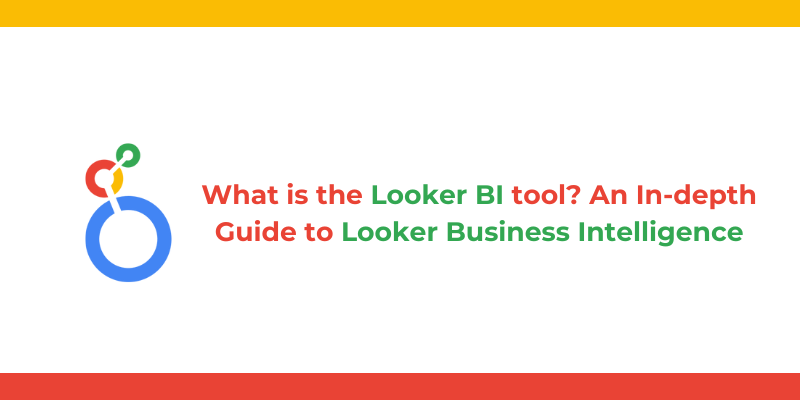What is the Looker BI Tool? An In-depth Guide to Looker Business Intelligence
Looker is a platform which assists you in exploring, visualizing, and sharing data. This data allows institutions to take effective decisions. Users can generate and share reports easily with the help of this business intelligence tool. Analyzing data and discovering insights within your business is simplified now. In this in-depth article, you will be discovering ‘what is Looker BI?’, its core values, features, and pain points. Let's get into it.

What is Looker BI?
So, what is Looker BI?
This cloud computing platform serves you data analytics and business intelligence (BI). It permits users to evaluate and examine data from diverse sources. Businesses can make data-driven decisions with the help of the insights it provides. It is set out as a Software-as-a-Service as it is accessed through a browser.
It produces instructive dashboards and charts with its capabilities for data exploring and visualization. Its key purpose is to assist institutions to analyze, explore, and extract enriching data from varied sources. Its end-user interface allows you to explore data. It has a development paradigm for discovering data. Its API supports data in other systems.
Core Values of the Looker BI Tool
Our world is steadily dependent on data. In this data-driven world, Looker is a promising tool assisting businesses to engage with data efficiently. Let's go through some essential core values of the Looker BI tool which defines its valuable approach.
- API-first & Cloud Native Integration - It’s an approach which emphasizes smoothly integrating Looker into existing workflows.
- Semantic Modelling & Governance - This core value of Looker allows it to make sure it’s promoting accuracy and consistency within wide governance of data.
- In-Database Architecture - Looker’s architecture is a gateway to real-time data. This data allows users to make smart decisions based on relevant and brand new information.
Looker BI Features
For all your analytical needs, Looker is a go-to solution. Almost every business intelligence tool allows you to form dashboards and reports. Then what makes Looker different from other BI tools? Let's discuss some of the key Looker BI features.
- Browser-Based Access - This browser-based tool puts an end to installing local software. Smooth workflow and a simplified user experience are ensured through this tool. It supports data-driven decision-making and collaboration. Users can extract business insights from any device or location.
- Looker ML Modeling - This modeling language is curated for simplifying data modeling. This encourages effective data analysis and data governance. This feature of Looker course can define metrics and data structures.
- Activations and Remarketing - Looker BI’s Activations and Remarketing capabilities outdo conventional analytic methods. It offers native integrations with Facebook and Google Ads. It rationalizes the remarketing process which allows users to create models and examine data with its interface.
- Multi-Platform Data Integration - Looker BI’s unified data is evident in its ability to discover, connect, and present data across diverse platforms. Data can be integrated from cloud services, third-party applications, and other databases.
- Embedded Analytics - Embedding dashboards into workflows or applications improves productivity by putting an end to switching between platforms.
- Augmented Analytics - This feature of Looker has the capabilities to detect changing needs in market data. It allows risk analysts to actively adjust portfolios.
Who should Learn Looker BI?
It's essential to recognize the right audience to align with the subject. For an effective implementation of Looker BI, finding people who would be suitable for using the same is a significant step. So, who should learn Looker BI?
- Data Analysts - They are responsible for detecting sales trends and advancing inventory. Looker’s interface and its capabilities can assist analysts with creating dashboards, keeping track of sales performance, and customer requirements.
- Business Intelligence Professionals - They can grasp the features of Looker for advanced analytics and smooth integration. Obtaining data from varied sources can be a tough task. Looker’s approach would allow these professionals to smoothly integrate it within relevant sources of data. It would reduce reporting errors and ensure compliance.
- Decision Makers - They can take advantage of Looker’s insights and dashboards. Looker’s reinforced dashboard can provide key performance indicators and advance operational efficiency of diverse business units.
Pain Points Addressed by Looker BI
We have thoroughly discussed the advantages and essence of Looker BI. For a strong understanding of any subject, it's vital to know both pros and cons of it. Looker addresses various challenges faced by institutions in their journey of data analytics. Let's discuss it.
- Dashboard Overhead - It decreases the overhead by removing the necessity for multiple dashboards for diverse use cases.
- Data Silos - There is data stored in silos or cubes which results in lack of trust across the organization. Looker can settle this challenge with its semantic modeling layer which serves a unified data view. It breaks down silos and provides consistent metrics across institutions.
- Learning Curve - Its easy learning curve eliminates the matter of costly self-service tools. It provides insights without requiring extensive training. It leads to better decision-making and faster adoption.
- Looker Integrations - Looker is clearly versatile when it comes to integration with diverse platforms. Organizations can connect market performance data with Looker analytics. This would provide an organization with conversion metrics, click-through rates, and other valuable insights.
Conclusion for ‘What is Looker BI’
In the end of our article, ‘What is Looker BI’, we can conclude its essence. With changing business needs, Looker provides an adaptable and various tools meant for different use cases within your company. Looker would assist you in comprehension channel performance, analyzing performing revenue to increase profits.